The war after the war: Georgia and Moldova
Octopus’ Tentacles of the Russian propaganda
Georgia and Moldova both have in common hospitality, good wine and deep wounds in the history of the last quarter century of their countries. Two wars in Georgia and one in Moldova, orchestrated by the Russian Federation, have split territories, cost human lives, separated families and wounded people. After the terrible wars, self-proclaimed entities appeared: Abkhazia and South Ossetia in Georgia and Transnistria in Moldova. All 3 separatist regions continue to be backed illegally by the Russian Federation, through propaganda and disinformation, a strong tool, powered from Moscow. A team of journalists from Georgia and Moldova tried to find out how Russian propaganda works in both countries, with a focus on the breakaway regions, especially in the separatist regions and in the context of the war of aggression launched by the Russian Federation in Ukraine..
"Go up to the stone blocks at the beginning of the bridge, we can no longer guarantee your safety if you go any further," says a Georgian policeman when he allows us to film the area by the crossing point over the river Enguri, which separates Georgia from Abkhazia, a secessionist republic that self-proclaimed independence after the 1992–1993 war. From the police station near the city of Zugdidi, Samegrelo-Zemo Svaneti region, we travel about a half kilometer to reach the Border Police.
There’s heavy traffic to and from Abkhazia. People walk, bike or drive to the bridge over Enguri and back. Some arrive by taxi or minibus to the police station, after which they walk a few kilometers or hitchhike.
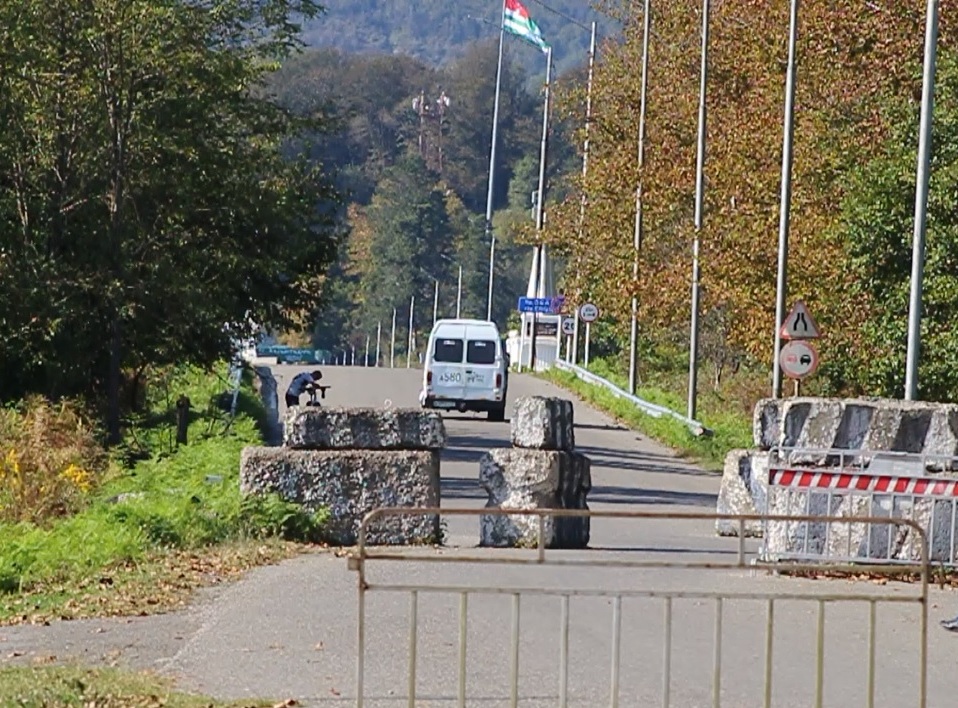
Only cars with Abkhazian plate numbers can go to Abkhazia, Georgian plates are not allowed. Not many Georgians go to Abkhazia either. Those who were forced to flee during the war and who have relatives on the other side, need a special permit to visit, which is extremely difficult to get.
"There’s a lot of uncertainty in these territories, you must take a risk to go there, there is criminality, anything can happen," says Gocha Minjhoraia, a journalist from Zugdidi, who accompanies us.
Georgians who chose to stay in Abkhazia, but also Abkhazians themselves, often come to Georgia for medical exams, medicine, food and much needed first-aid supplies.
"We receive small pensions; we cannot find many of the medicines we need in pharmacies and the ones we do are expensive. It's hard to live here. Once a week, I walk there [Georgia] to buy the necessary medicines, so I can survive,” says an old woman.
Next to a car, three men and a woman load several household items in a hurry: plastic bowls, washing powder and towels, the cheapest ones. "It is not bad in Abkhazia, we live really well, come and see," says one of the men and the car with Abkhazian plate numbers leaves.
Somewhere over there, an elderly woman is waiting, obviously worried, staring at the road from the bridge. She tells us that she is waiting for her nephew, her sister’s son, who, after the war, chose to stay in her parents’ house. She hasn't seen her grandson for years. She worries and fears that the boy will not come. She needs treatment. As she sees him, she calls a young man driving a white car to go and meet the boy. She has tears in her eyes and she rushes to hug him when the car nears her.
Medical assistance
In the meantime, an ambulance is coming. From the Abkhazian side, a car speeds and stops near the ambulance. An old woman is taken out on a stretcher. The doctors in the ambulance provide her first aid, take her blood pressure and an electrocardiogram. The ambulance driver tells us that they have dozens of calls daily and during the night as well.

"In Abkhazia, there is a lot of corruption and bribes, but our pensions are so small and not enough to pay. We are always told that Georgia is bad, that they will kill us, but we come here because we get free medical care and medicine,” says a man.
People pass quietly from one side to the other without checking their passports. The continued presence of camouflage, military equipment and concrete blocks, reveal traces of a war that has not ended.
The bridge over Enguri begins just past the concrete blocks, and there, in the middle of the bridge one can see the flag of the self-proclaimed breakaway republic of Abkhazia. On the other side, Russian soldiers make sure to check every passers-by thoroughly.
Only our colleague from Georgia goes any further. She was born in the Gali region and was forced to flee with her parents in 1993. One of her sisters still lives in Abkhazia.
A Day in Abkhazia
“Whoever has an Abkhaz passport, goes first!” - says a border guard who serves at the Enguri Bridge checkpoint, which separates Abkhazia from the rest of Georgia. The boundary line between Georgia and Abkhazia appeared after the 1992-1993 Georgian-Abkhaz war in which the Russian Federation militarily backed Abkhazia to separate from Georgia.
When you enter Georgia from Abkhazia you do not have the perception that you are crossing a border, but as you cross the bridge into Abkhazia, you can sense a real military presence: a military post, with armed people, and further on - a military bunker. The soldiers speak only Russia and no Abkhazian is involved in checking documents or guarding the so-called border.
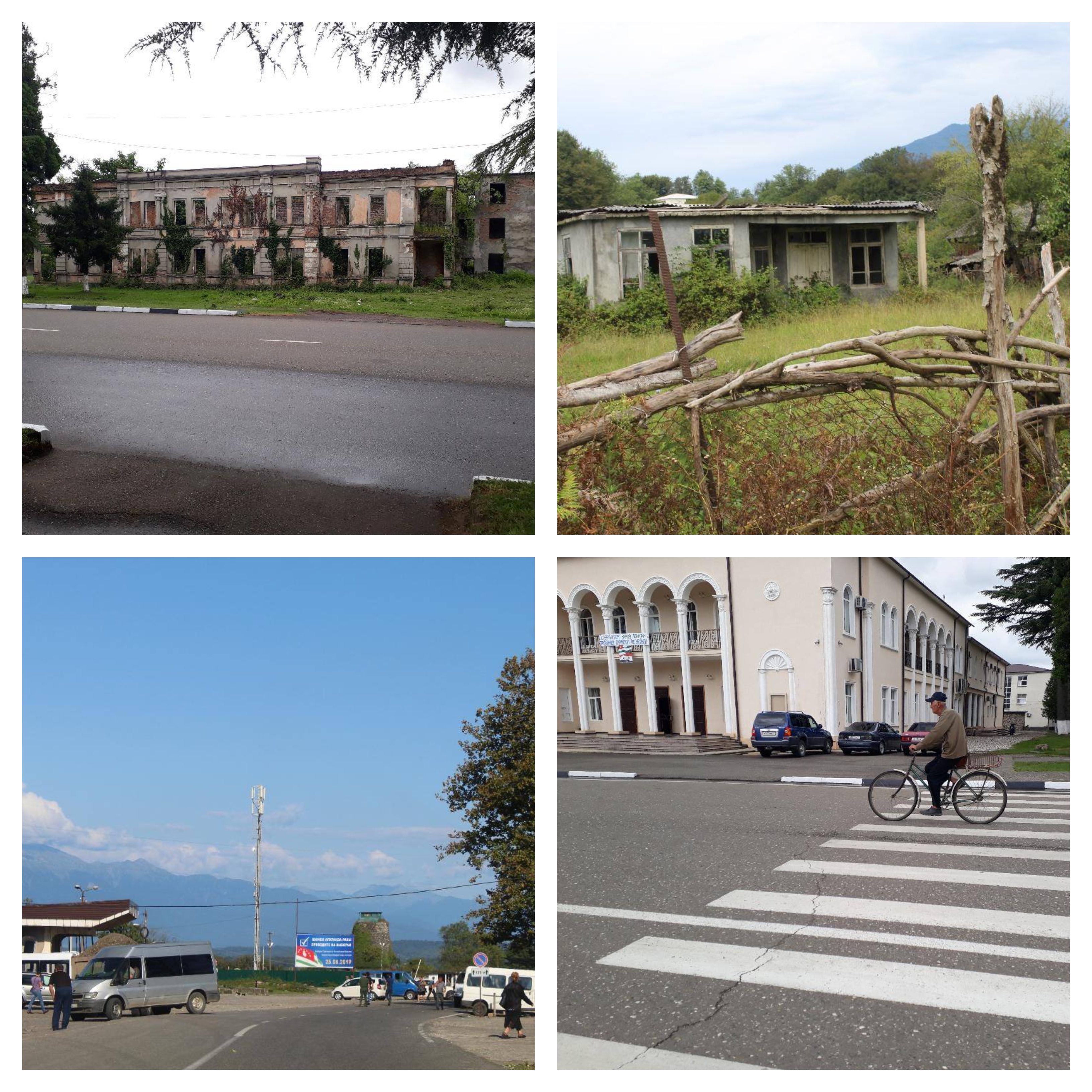
Russian soldiers first let those with Abkhazian issued passports through and then begin carefully checking the passports of others coming from Georgia, even though most of them are natives of the Gali region. In order to cross, you need a permit, which is difficult to obtain from Abkhaz authorities. They allow you to take photos only until you reach the control post. In Abkhazia, you are not allowed to take any photos. If you have any kind of camera, you immediately draw the attention of Russian militia men or the military, and they may ask you to delete all photos and videos taken in Abkhazia.
"Hard and unbearable," this is how life is described by residents of the Gali town, from the region with the same name in Abkhazia, which is inhabited mainly by Georgians.
The frozen nature of the conflict has had a severe impact on residents living on both sides of the Enguri.
Abkhazian authorities often close the border crossing to Georgia and Georgian ethnic groups in the Gali region are forced to pay bribes to cross the border, especially when they have certain emergencies. The bridge over Enguri was closed for 3 months in 2019, which undermined the lives of about 30,000-40,000 people living in the area.
According to the European Union Monitoring Mission (EUMM) survey, 2,580 people cross the Enguri Bridge checkpoint every day.
For Georgians living in Gali, that bridge represents a path to better schools, hospitals and family. They cross it to go to cheaper shops and better services, as well as for weddings and funerals. Students go to universities to learn in Georgian. But for most, the road to Georgia is blocked.

Thousands of Georgians fled during the 1992-1993 war, yet most ethnic Georgians returned to Gali when the war ended. Some of them, mainly the elderly population, never fled to begin with. Nowadays, the elderly make up a majority of the district’s population. Today, many wonder if the return was a mistake, as Georgians continue to be marginalized and feel powerless, without being able to settle down on the lands owned by their ancestors. Abkhazia, once rich and full of tourists, is now poor, ridden with corruption and crime.
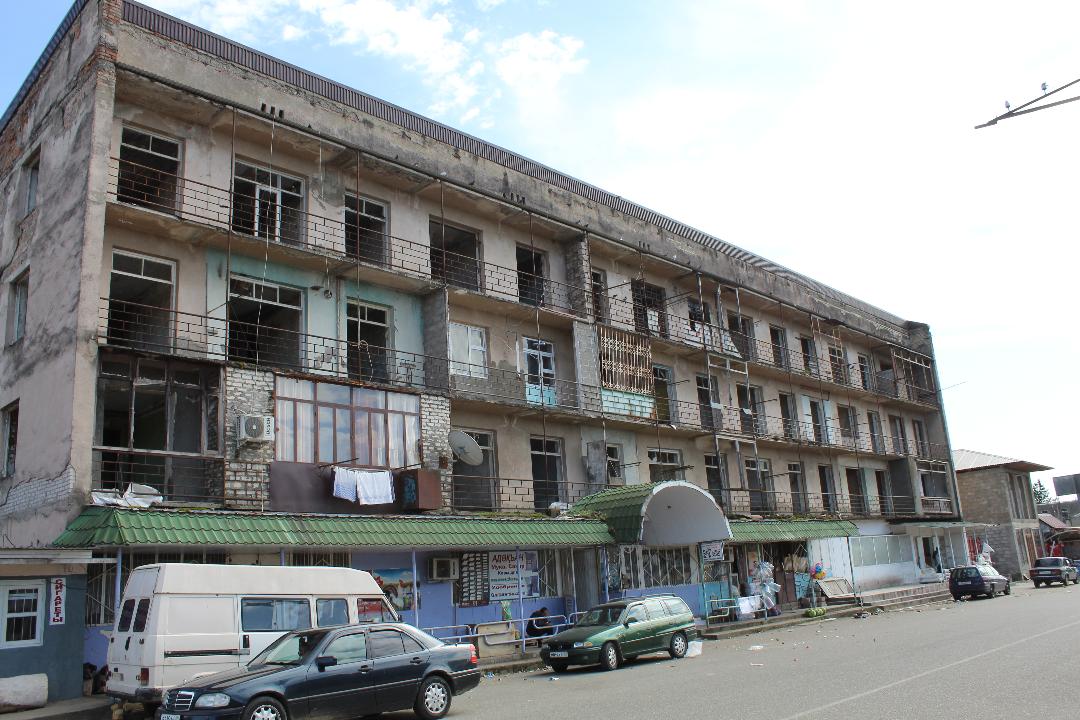
The Georgians in Gali complain that their freedom of movement in the region is restricted and that they are hardly able to obtain any Abkhazian documents. They are not allowed to learn in Georgian and are required to learn Algebra, Chemistry, and Physics in Russian. Moreover, they are learning the History of Abkhazia and Military Training.
Natia, a 16-year-old girl, goes to a school in Gali. She shows us her textbooks. All of them are published in Moscow, in Russian. Natia's mother tells us that Gali students find it very difficult to study in Russian.
"I have four children and they all go to school. I always help them to translate texts from Russian into Georgian so that they can understand what they are learning. Even teachers, who are Georgians, do not understand Russian well, but they are not allowed to teach in Georgian. We cannot explain it very well, because during the Soviet period, I studied in Georgian at the University. Although it is difficult for me, I try to help my children to learn so that they can have a future,” says another mother.
Marina, 55, does not see a future for her children in Gali. Like any mother, she would like them to be near her and she hoped that the situation would improve. Now, however, she does not really believe that this smoldering conflict will ever be settled. "There was too much pain and still is. It's hard to get over that. Maybe the wounds don't bleed anymore, but we can't forget the past, it’s too difficult,” says the woman.
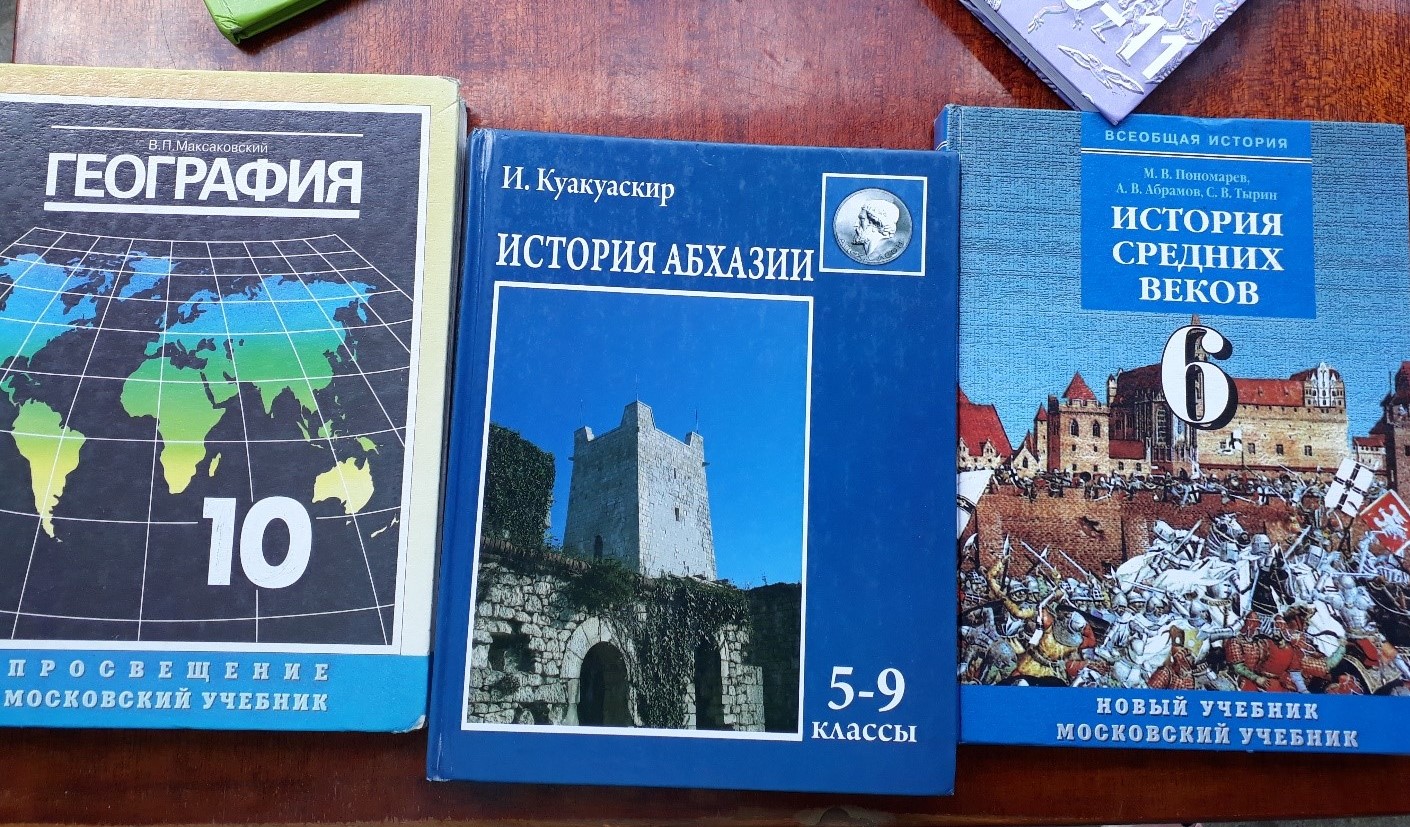
Propaganda through media
The real problems faced by the population of the Gali region are not covered by Abkhazian media. If something is written in the region, it's usually propaganda.
One of the main media institutions in Abkhazia and South Ossetia is the Sputnik news agency, which mentioned in one of their recent articles how easy it is to learn the Abkhazian language. The journalists wanted to make it clear that only ethnic Georgians say that it is difficult for them to learn the state language.
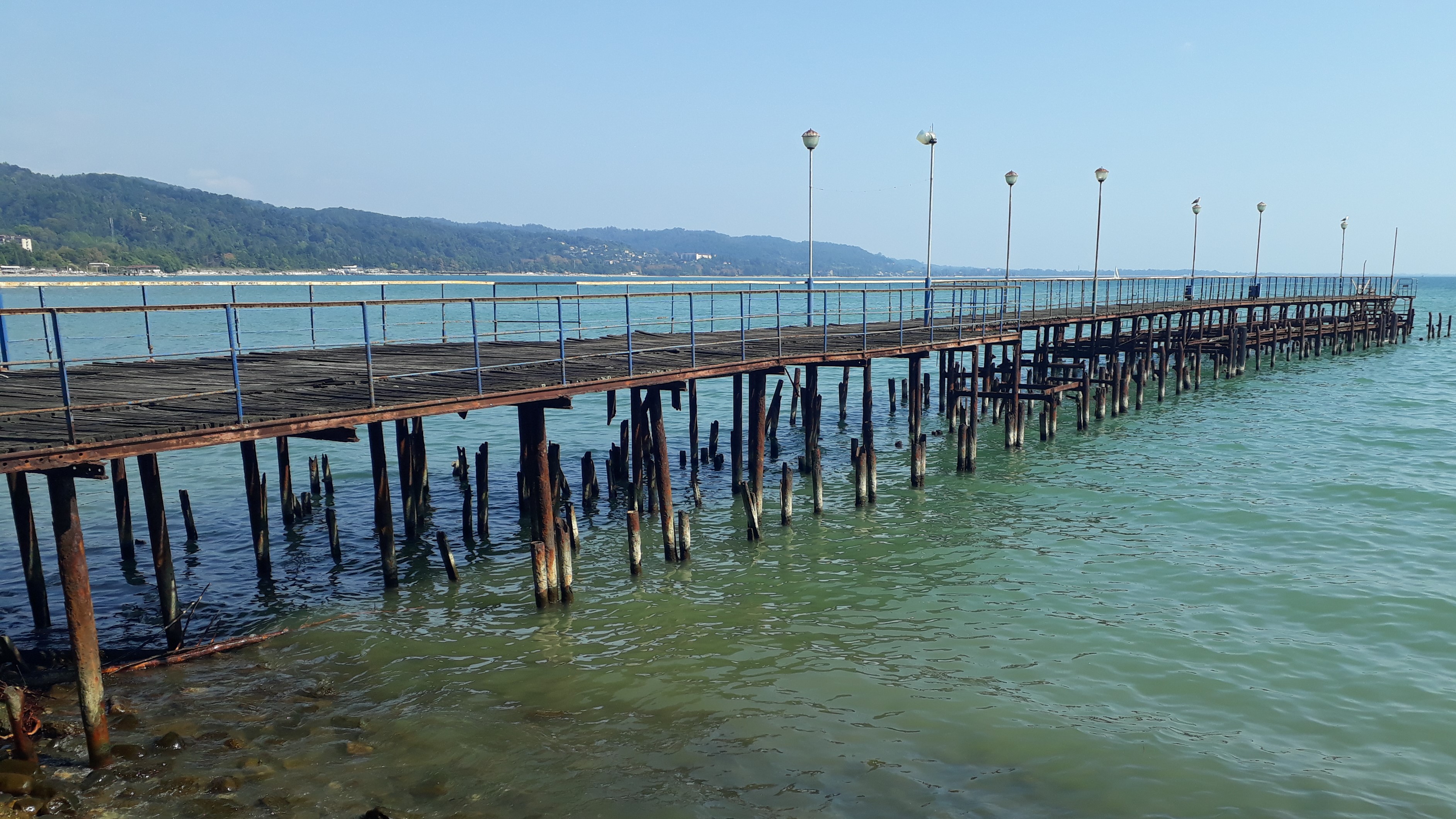
Sophio Chkhaidze, a researcher at the Media Development Foundation, says that Sputnik Abkhazia and South Ossetia have the same policy. The focus is always on how helpful Russia is in all fields, how they helped to modernize the army, how strong Russia is and how bad the European Union and member countries are in turn; this is the nature of propaganda that comes out of Sputnik Abkhazia and Sputnik South Ossetia. Talking about anti-western propaganda, Sputnik republishes and cites the Russian state news agency RIA Novosti. “They publish material from columnists whose texts are always anti-western,” says Ckhaidze.
Along with Sputnik Abkhazia, RIA Novosti and Radio Voice of Russia, there are several other media outlets in Abkhazia that broadcast similar messages of propaganda. These include Apsni.ru, Аиааира.Info and Informeaza Abkhazia. In the Gali region, there is a Gal TV government television, which writes about the successes of the Abkhazian government.
Interestingly enough, you cannot find any information anywhere on the funding sources, employers and beneficiaries of Abkhazian media outlets. The few TV channels, portals and newspapers published and broadcast in Abkhazia do not mention the source of their funding, not even those that are known to be financed from the budget of the unrecognized republic.
Gocha Minjhoraia, a TV journalist from Zugdidi, who accompanies us in the region, has collaborated several times with journalists from Abkhazia on documenting common topics but they have never published anything in Abkhazia. "They are not allowed; they filter information there. They must write down what they are asked to. Most accept these conditions, because they have no other options,” says the journalist.
At the border with South Ossetia
South Ossetia, the second secessionist enclave, broke apart from Georgia after the Russian-Georgian war in August 2008. Moscow has since recognized the independence of the separatist republic, along with Nicaragua, Venezuela and several other Pacific island states. After the war, Russian officials signed a security treaty with South Ossetia, pledging to cooperate on border security.
Russia has de facto control over both South Ossetia and Abkhazia. Since the 2008 war, Russian soldiers have erected barbed wire fences even through Georgian localities. Residents in the region say you can fall asleep in Georgia, and overnight, you will wake up to find yourself under Russian occupation in Ossetia. This is because the Russian military often changes the demarcation line, slowly advancing further into Georgian territory. As in Abkhazia, on both sides, Georgians have been living for centuries. Although over 10 years have passed since the six-day war, the challenges facing the region have not changed.
The main crossing point to South Ossetia and the Akhalgori Valley completely closed on September 4 and was opened only in December. As a rule, about 400 crossings are recorded daily.
Margo Martiashvili, who suffered a stroke in the Russian-controlled Akhalgori district, died on 28 October in the hospital of Georgia’s Russian- occupied Tskhinvali region as her relatives could not transport her to the Tbilisi-controlled territory via the shortest road due to the closure of the so-called border.
The renowned Georgian doctor and traumatologist Vazha Gaprindashvili was illegally detained near the village of Orchosani [under Russian control] on November 9, and was charged with “deliberately crossing the border" into Georgia’s Russian-occupied Tskhinvali region.
There are Russian soldiers with Kalashnikov’s (AK-47) at the checkpoint to the entrance to South Ossetia and to Abkhazia.
The six-day war in August 2008 between Georgia and the military of the Russian Federation greatly increased the divide between Georgians and Ossetians. Poverty and crime have taken over this region as well.
A Day in Transnistria
The Transnistrian region of the Republic of Moldova separated in 1991, and a year later, a war of several months followed that was backed by the 14th Army of the Russian Federation, stationed in the region during Soviet times. This army was ready for war in the Balkans. Despite several international agreements, the Russian military continues to station troops in this secessionist region. Unlike Georgia however, the Republic of Moldova has no border with Russia. Moldova borders Ukraine, in the Transnistrian region for a distance of about 400 km.

One big difference which I saw immediately was that unlike Abkhazia and the rest of Georgia, people from Transnistria and Moldova get on well with each other, without any restrictions. Unlike Abkhazia, my hometown, I had the feeling that the Transnistrian conflict is almost over.
I hesitated when my colleagues from Moldova invited me to go to Transnistria, but, to my surprise, as a citizen of a foreign country, I entered the separatist region without even getting out of the car. I didn't even see the border guards’ faces. The driver went with his passport to a checkpoint and in 5 minutes we continued on our way to Tiraspol. In Abkhazia, the citizens of a foreign country must first ask the relevant institutions for a permit and even then, they cannot be sure that they will receive these documents.
In South Ossetia and Abkhazia, freedom of movement is the most complicated issue facing ethnic Georgians in the Gali district for instance, while crossing the checkpoint. The roughly half a mile stretch or 870 meters of the Enguri Bridge, is the only legal crossing point into Georgian-controlled territory. The bridge marks the boundary line between Georgia and Abkhazia – geographically close to the meandering line of the Enguri River.
We crossed the checkpoint in Transnistria without even getting out of the car, which is not possible in Abkhazia. There, people walk the 870 meters across the bridge only to stay in line until their documents are verified by Russian military personnel, who often subject them to a great deal of questioning. In recent years, the situation has only worsened, with bribes becoming commonplace.
While Abkhazia continues to show traces of the war, in Transnistria it’s very difficult to find any signs of the conflict that broke apart Moldova. The cities and villages in the region look rebuilt and cleaner. What I noticed most however, is that people on both sides of the Nistru do not hate each other.
At the market in Tiraspol, I met people from the right side of the Nistru who come to sell their agricultural products. "It has always been like this. I traded here, because the market is bigger and you can make money. What to do if we have no other way to handle it? The pension is small and you can't get enough of a living,” says a pensioner.
Another man, a little younger, tells us that he is from Tiraspol, but he has difficulties, he doesn't have a job and he has to come and sell things at the market to make a living: “Politics separate us. Politicians are fighting each other and they forget about ordinary people. They don't care about our problems.”
Most of the people we meet in the market are open to speaking but become apprehensive and walk away when asked about Tiraspol’s leadership.
The city of Tiraspol is under reconstruction, the main arteries of the city are being repaired, multi-storey buildings are being erected. The Sheriff company, which has controlled all business in the region for years, has built a modern stadium where international football matches are played. One of the matches in the World Championship preliminaries was played in Tiraspol. Moldovan Prime Minister Vlad Filat also attended the event.
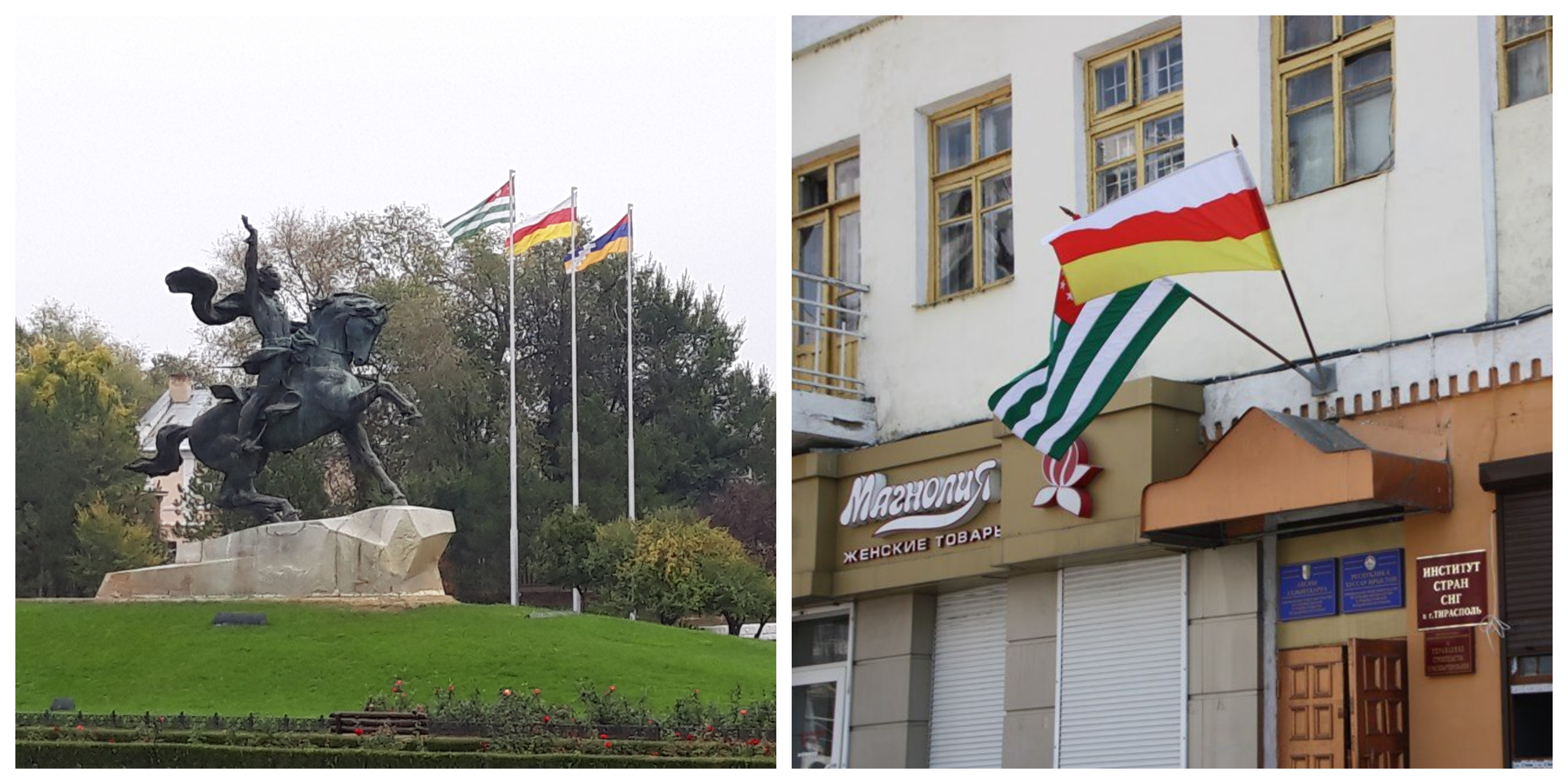
In stores, most of which are owned by the Sheriff company, the shelves are full of Ukrainian and Moldovan products. You don't see any Russian products, and from the local ones you can find only the famous Kvint wines and cognacs. Particularly surprising for us is the fact that you can pay with the bank card of a foreign country, such as Georgia.
Even with the seeming openness between the two sides, with citizens able to move freely between the two sides and economic agents able to export with the trademark of the Republic of Moldova and thus avoid taxes, the Transnistrian conflict is not settled. It has been smoldering for almost 30 years, like many of the other conflicts in former Soviet states. Russia continues to rule this region, dictate the rules of the game and control citizens through propaganda.
Clashes often occur in the Transnistrian region. The Transnistrian militia unofficially collaborates with Moldovan police. The latter have in many cases helped to arrest or even kidnap people, who are then taken to the Transnistrian region, tried and imprisoned. In 2019, the unrecognized government of Tiraspol installed 22 so-called guard posts along the administrative demarcation line and refuses to withdraw them, despite repeated demands to do so from the Moldovan delegation within the framework of the Joint Control Commission. They do this despite the fact that the setting up of military structures in the Security Zone is prohibited by the Moldovan-Russian Agreement, signed on July 21, 1992.
Russia, which has gone from aggressor to peacemaker, is part of the negotiation process for the conflict settlement along with Ukraine, the US and the OSCE. "It is nonsense for Russia to be considered both an occupant and a peacemaker, as a guarantor of the settlement of the conflict it has caused. In such circumstances, the political class should find solutions to persuade the Kremlin to recognize its occupation and to remove its consequences. Otherwise, with occupied territories, it is impossible to imagine that the Republic of Moldova can claim its right to join the European Union or NATO. Until the elimination of the occupation status, one cannot talk about the union with Romania,” says the Moldovan political analyst Igor Botan.
In 2017, the Constitutional Court of Moldova issued a decision stating that Russia illegally occupied Transnistria. However, Chisinau politicians quickly chose to forget about this ruling. "The judgments of the Court are compulsory and, of course, if Russia is an occupying state, measures should be taken to review the full spectrum of relations with this country, including the termination of the 1992 agreement, as provided in the Art. 8 of this agreement,” argues Igor Botan.
Hybrid War: Same tools and messages
In both Georgia and Moldova, propaganda and misinformation go hand in hand. Media messages are strikingly similar: crime and homosexuality are purported to come from the EU and the theme of migrants is the same on the agenda for both countries.
In Moldovan 2016 Presidential election, the supposed migrant threat was that Maia Sandu, the opposition candidate to the pro-Russian Igor Dodon, would bring 30 thousand Syrian migrants to Moldova if she won. Dodon became President due to the barrage of such fake messages that targeted financially vulnerable and poorly informed voters.
In Georgia on the other hand, Turks, Syrians and Iranians are all considered potential migrants that pose the threat of invading the country. The media in Georgia has spread the propaganda that Iranians will buy up most Georgian properties, this despite the fact that according to official statistics Russians are the number one nationality buying up real estate.
In Moldova, propaganda is spread through several pro-russian media outlets, some of which are funded by Moscow, such as the Sputnik Agency. As in Georgia, Romanian-language media institutions, supported by pro-Russian parties, the largest being the Socialist Party backed Igor Dodon, promote propaganda.
Studies by media organizations show that in Georgia propaganda is spread through local, Georgian media, as opposed to Russian outlets. Here the local population gave up watching Russian media a while ago and no audience exists for it.
In 2008, Georgia banned Russian TV channels, and even when they reappeared in 2012 Georgians did not watch them. That is why Russian propaganda is spread through local outlets. According to the monitoring, those that promote Russian propaganda, are funded by the state agencies, which give them money for advertising, that is, from public money. Unlike Moldova, Sputnik agency does not broadcast in Georgia, because it does not have a license, but it is quite active in the secessionist regions. NTV tried to enter the media market, but the Georgian authorities banned the release of frequencies.
Russian Propaganda in Georgia
Helen Khoshtaria is an opposition MP in the Georgian Parliament. She says that propaganda is used for strategic purposes by Russians, to prevent the full independence of formerly Soviet states such as Georgia, Moldova, and Ukraine.
This has been a particularly widespread tool used to provoke conflicts first in 92-93 in Georgia and Moldova, as well as later on in 2008. The second tool is to “influence our states, against development, against joining the EU and NATO. They provoke and use national feelings,” says the MP.
„ In Georgia, this works through direct agents, parties, NGOs and influential groups, through churches, and recently, through government structures. There must be resistance. Also, it is important how the government fights propaganda, how the government is positioned: fights or is on the same side of it. There is a problem: the Government does not fight; its representatives collaborate with certain groups and even share certain propaganda messages that Russian agents would like to be distributed in Georgia,” said the MP.
She says that Georgia has to talk to the whole world about the history it went through. “We have to say that our territories are occupied, that we have a humanitarian catastrophe, thousands of people have taken refuge, have been displaced. We must say how Russia violates international law. The second way is that we must find internal resources to develop ourselves, to show that we are always facing a military siege, but we must develop ourselves, to become attractive for the people under occupation, to join the international organizations and to become attractive at an external level," says Helen Khoshtaria.
“Dangerous talks start, Russia did not start the war, but Georgia"
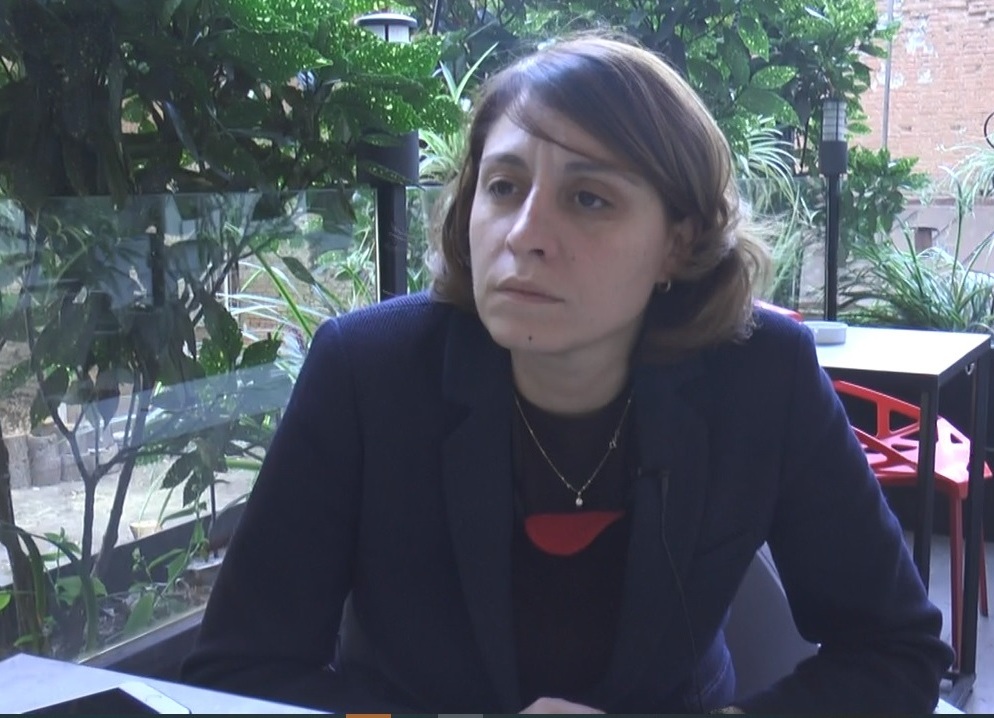
MP Khoshtaria is worried that lately, the Georgian government "starts dangerous talks for Georgia's independence, for example, who started the war and there is the idea that Russia did not, but Georgia,” says the MP.
"This happens during the period when the EU opens markets, when we have to integrate into the EU, but at the same time, there are statements that we could not survive without the Russian market."
"When the Russian Federation banned flights, the Government subsidized some flights from Russia, even with these restrictions, the number of tourists did not decrease," says the MP.
She is outraged that the Georgian authorities did not include Russian officers in the lists of persons who participated in the killing of Georgians, even though there is video evidence which shows the atrocities they committed.
"We have videos of how Russian occupants kill people, but no Russian officer is listed. So, they work to not upset the Russians. The government collaborates with influential groups saying that the US is evil, that it fights against homosexuals, and in such a way, apparently, the integrity of the people is defended. All this is convenient for Russian propaganda,” says the MP.
In Chisinau, talks about who stopped the war in Transnistria
Not surprisingly, the same discussions, about the Nistru War of 1992, also take place in Chisinau. Recently, the Minister of Foreign Affairs and European Integration of the Republic of Moldova, Aureliu Ciocoi, said in an interview that the Russian Army stopped the bloodshed in 1992 in the war in Transnistria. The statement of the official is strongly criticized. Expert Dan Dungaciu says that the Moldovan diplomat's statement "transmits that the positions of Moldova on Transnistria start officially to overlap with the position of the Russian Federation.”
Propaganda through media, funded with public money
As for the media, Helen Khoshtaria says that in recent years propaganda has been spread through some Georgian media. "Anti-NATO, anti-EU sentiments are being discussed on the public TV channel. We have often wondered why this is done with our money; it is propaganda funded by our money. Other extremist media institutions, which promote xenophobic, anti-EU messages, essentially those that promote Russian propaganda are supported by government agencies, from money for advertising. "This propaganda is spread through our money. I am not for closing these media, but there must be a strong attitude and they should not be financially backed. The government is against the pro-European opposition, but it does not have the same attitude to the pro-Russian opposition. In the last few years, we have been wasting a golden opportunity for democratic reforms - we are in a space full of conflicts and problems, the criminal situation is getting worse, this is affecting tourism as well.”
"Russia continues to be an obstacle. Moscow knows that if people live better, EU integration will become a reality and this will give more chances for occupied territories,” says Helen Khoshtaria.
Hybrid war
Journalist Irakli Tabliashvili says that after the 2008 war in Georgia, Russia unleashed another war, of propaganda and misinformation: "Moscow was mostly disturbed by Georgia's intention to become a NATO member. Hence, the military aggression and then the hybrid war. The hybrid war is not only from propaganda and misinformation, but also from all kinds of other pressures: psychological, economic, political. Russia managed to stop Georgia's development for a while, but did not win. Georgia has not lost its statehood and has even managed to develop anyway.” Regarding the territories occupied by Russia, Tabliashvili claims that there is little information here, but through propaganda and misinformation the population is manipulated. And this is because people are poor, do not have media alternatives and Russia does its best to prevent the citizens of this territory to keep in touch with the Georgians on our side, to see how the situation in Georgia has changed after the war.”
Tamar Khorbaladze is the chairperson of the Media Development Foundation. The organization has been monitoring media in Georgia for several years with a focus on propaganda. She says that Russian propaganda in Georgia targets messages about the danger to Georgian traditions, for example the sanctity of the ‘Georgian family,’ that is, it uses national feelings, traditions, values, and induces fear that these are under threat: “Some messages scared people that the government was committed to receiving more migrants from Syria and Iran and that the Georgians will become a minority." In the end, the messages had an impact: the number of tourists from the above-mentioned countries decreased.
„Propaganda is out of control on social networks”
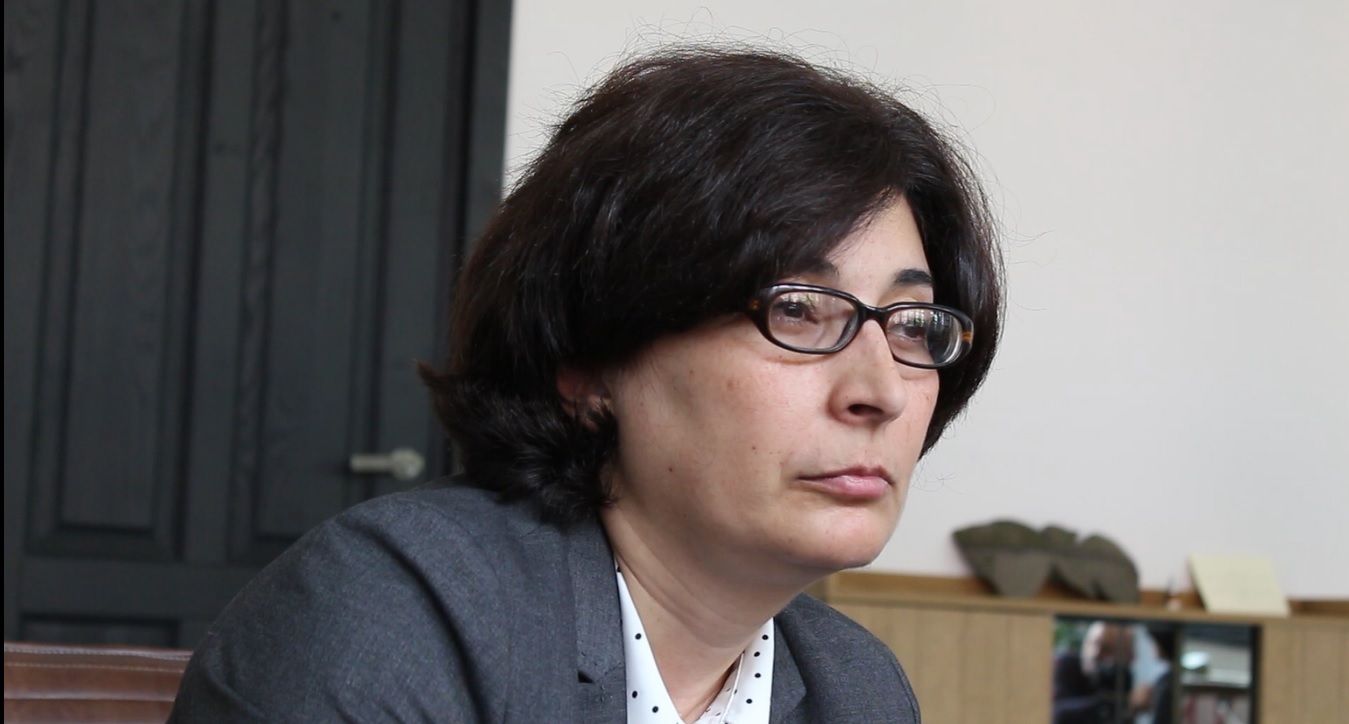
"When we talk about propaganda, we have to consider new media - social media in particular because it is very popular. It is very difficult to fight social media propaganda. The most frequent messages are about murder, homicide in the West, they say that the first sexual experience children have with their parents and this will happen in Georgia, if we join the EU and the US. So, they talk intensely about how bad the West is,” says the expert.
"It is difficult to fight Russian propaganda, which is massive, there are big resources and they work in a lot of different directions."
Last but not least, in Georgia the Church plays a negative role in the distribution of Russian propaganda. While there are a few elements that oppose this, the overall system works for propaganda.
As for the propaganda in the occupied territories, Tamar says that there is not much connection with the people there, there are no free passageways, they go in secret, people do not talk about it, so that they do not have problems.
"We are not very active either. We have taken a position, we pretend that we do not notice, we know, we do not forget. There is very little information from the occupied territories. But there is a lot of misinformation out there. When more Abkhazians came to a football match, they were surprised that no one killed them. A journalist who went through Zugdidi, later, wrote on his blog that he didn't want to see all this. Russia did and does its best to ensure that the population in the occupied territories does not receive truthful information,” says Tamar.
Hate speech, more temperate
In recent years, the hate speech against the Abkhazians or the Ossetians has almost disappeared. "There is no hatred against the Abkhazians or the Ossetians as it happened in the 90s. This is different from Karabakh where there is hate speech in the media. And the hatred against Russia is diminishing, but it has increased against the West, against LGBT people,'' says the expert.
I asked Tamar and other people which we met in Georgia and Moldova, what would be the way towards change and counterpropaganda. There should be a rising level of critical thinking among media consumers, among young people, in particular, those who use online media which is full of propaganda, she tells us.
"We can be ethical, but the information does not pass only through the media, but also through social networks. If you do not have a good average training, you will not face it. The West did not respond adequately and in time to Russian propaganda and unfortunately this is an advantage now. It is not at all optimistic what I say. The European integration strategy includes a strategy to protect the information space. NGOs and not the Government are working on it, but these organizations are not considered partners, but enemies,” says Tamar Khorbaladze.
Vladimer Menabde, editor-in-chief of the regional publication "Guriismoambe" in Ozurgeti city, capital of Guria region, tells us that the media and the regional media have been heavily influenced by Russian propaganda in recent years. He believes that some patrons of the media are paid by the Russians to spread fake content.

“In our region, which was always full of Russian agents during the Soviet Union, because it is at the border with Turkey, it is not difficult even now to find agents who work for Moscow. And as the regional media faces financial problems, some editors and journalists accept for some money to promote what Moscow agencies want ... It's sad, what is happening in some Georgian media institutions in the regions," says Vladimer Menabde.
Russian propaganda in Moldova
Journalist Lilia Zaharia from Chisinau is the manager of the webpage Stop Fals, which debunks fake news and misinformation in Moldova.
She says that Russian propaganda has a big impact on Moldova as it has a lot of pro-russian websites, such as: Комсомольсkая правда, Молдавские ведомости, Sputnik Moldova and other TV channels and radio stations.
These sites publish many misinforming texts. False and biased news are then taken over by dozens of other media outlets. Most often, they write about the EU or NATO in a bad light. Also, Ukraine and Romania are portrayed in a negative light.
"In our country, the newspaper Комсомольсkая правда has the most sales. Through this newspaper, Russian propaganda has its negative effect on people. The articles published by this newspaper incite hatred, provoke Moldovans and Russians, native speakers of Romanian and Russian, against each other, through messages related to Romanian and Russian languages, history of the West and East. Moldova does not have state institutions that are focused on combating misinformation and fake news, and these activities are carried out by civil society and some journalists who reveal fake news and misinformation. However, the process of informing citizens about how to detect fake news, how to understand propaganda, is quite difficult, because 70% of the Moldovan media spreads propaganda and misinformation daily,” says Lilia Zaharia.
In both Georgia and Moldova, disinformation has the same purpose, to remove our countries from NATO and the EU and to bring them further into Russia’s orbit, says Lilia Zaharia. Most fake news is spread during the election period. This propaganda works. In November 2016, Moldovan citizens elected Igor Dodon, who is a pro-Russian president, as part of an election campaign strongly influenced by pro-Russia messages and against NATO and the EU.
"We see the results of propaganda, misinformation during the election period. A year ago, most of the media was controlled by democratic leader Vlad Plahotniuc, but now this influence has passed to Igor Dodon and the Socialist Party which he continues to unofficially run. Pro-Russian TV channels back and promote the pro-Russian policy of Igor Dodon. These media promote many propaganda messages and they have particular influence in rural areas, where citizens do not have many alternative information sources,” says Lilia Zaharia.
Romanian bastions in Transnistria
In the breakaway region of Moldova, called the transnistrian region of Moldova, 8 schools have been the stronghold of Romanianism for almost 3 decades, and are subject to the complete russification of the region. The Romanian schools, as they are called by the authorities of the self-proclaimed republic, work under extremely difficult conditions, artificially created by the Tiraspol regime. 7 of the 8 schools do not have their own premises, and the rented premises do not provide elementary conditions for school activity. The educational institutions do not have the right to sing the anthem of the Republic of Moldova at the beginning and at the end of the school year, nor to fly the tricolor.
The lyceums in Tiraspol, Tighina, Râbnița, Grigoriopol, Dubăsari, and 3 gymnasiums - the boarding school for orphan children in Tighina, a town on the right bank of the Nistru, but controlled by the authorities from Tiraspol, the gymnasiums in Corjova and Roghi villages, Dubasari district, which are not subordinated to the self-proclaimed regime in Tiraspol. These institutions, funded from Chisinau, are really struggling.
Students learn from modern Latin textbooks. However, the situation is different in the "Stefan cel Mare” Lyceum in Grigoriopol, based in Dorotcaia village, after 2002 was evacuated because the separatist administration forced the school to teach in Cyrillic script. Since then, students from several villages, including Butor and Tashlâc, under the control of the Tiraspol regime, commute daily to Dototcaia, to learn in Romanian.
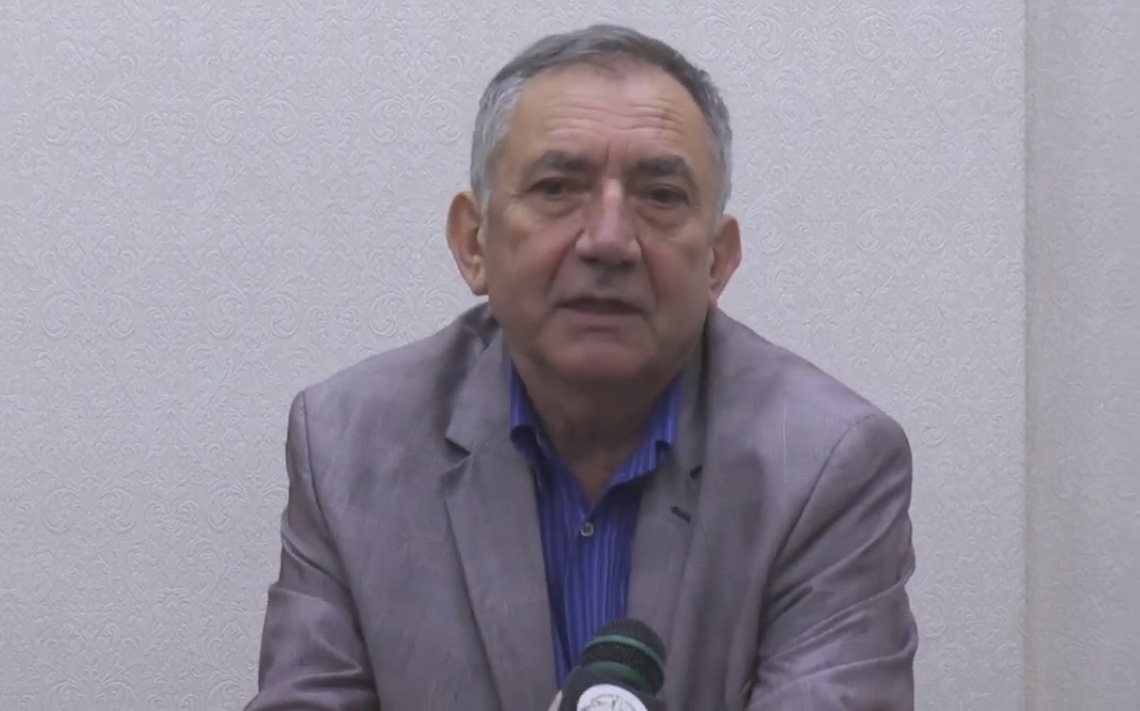
The schools teaching in Romanian language on the left bank of the Nistru have been, for the last 27 years, an exchange currency for the alleged authorities in Tiraspol in the process of negotiations with Chisinau.
In 2004 and 2006, parents, teachers and students from villages in Râbnița, Tighina and Grigoriopol complained to the European Court of Human Rights (ECHR) about violating several rights, such as the right to education, private life, non-discrimination.
In 2012, the ECHR acknowledged the violation of the right to education in relation to the Russian Federation. Also, the Court ruled that Moldova is not guilty of violating the right to education in these cases.
Romanian carols in the heart of Tiraspol
We arrived at the Theoretical Lyceum „Lucian Blaga” in Tiraspol on December 24th, on Christmas Eve and before the school holiday. The students, from small to large, dressed in national clothes sang to their teachers and parents. The Romanian language sounded beautiful in the carols and in the well-wishes accompanied by sounds of bells.
"We have children who came from Russian speaking families. They didn't know Romanian. They learned Romanian and now you cannot distinguish them from their colleagues,” says Ion Iovcev, director of the Lyceum, a Bulgarian by nationality, but who for 30 years has been teaching in Romanian, at the school located in the heart of Tiraspol, the capital of the separatist region.
"I think our greatest merit is that we were able to separate so many children from the ideology that is ... I can't call it even- communist, chauvinistic, pro- Russian. But we managed to make these children realize what it is like to be a free man, to have dignity and to know the European values. There are over a thousand students who graduated from this educational institution, this is a great achievement. We were so tormented in this town, there was devastation, destruction, but we, like the Phoenix bird were reborn from the ashes. It was hard, but also interesting - that's my philosophy of life. That, in fact, is my cross, which God and the teaching staff have given me,” Ion Iovcev tells us, when we ask him how he can survive here.
In Tiraspol, the anti-Western and anti-Roman propaganda dates from Soviet times. Later, the enemy's face was the USA and Romania. Brainwashing was spread through the media: newspapers, TV and radio stations, Tiraspol administration websites, says the director.
“Now, for Transnistria, the No.1 enemy is the Republic of Moldova and, of course, Romania. And we managed to have children in this institution not only of Moldovan nationality, as they say here, who are, in fact, Romanians, but there are also children of Russian nationality. The children and their parents realized that things are not quite the same, as the media reports. Many children came from the Russian kindergartens to us, they did not know Romanian at all, and now they speak Romanian very well. The students saw by themselves the houses of the Romanian writers, they visited and saw what Romania is like and they realized that it is different from the propaganda in Tiraspol”, says Iovcev.
Russian citizenship vs. Romanian citizenship
In the lyceum, we met a graduate of the school. Nicolae Romanov graduated from a university in Romania and he is now a PhD student at a University in Iași. He is on vacation and came to visit his teachers. All his former classmates left Transnistria, because they do not see any future here. Most of them are in Europe. He remembers that as a child, they were labeled by children who spoke Russian, as Romanians or fascists and even invaders.
"And the young people of my age who learned in Russian schools left, some - for Moscow, in Russia, but most of them are in Europe, which is blamed in Tiraspol. They have made Moldovan passports and benefit from the visa-free regime between Moldova and the EU. Some of them had Russian citizenship and they got the Romanian citizenship, which offers them more prospects,” says Nicolae.
Recently, the media wrote that the wife of the president of the transnistrian region of Moldova Vadim Krasnoselski, one of the promoters of anti-EU and anti-Romanian messages, has Romanian citizenship. Tiraspol leader has officially declared himself several times “free from the Romanians", this propaganda message being used very often in the Transnistrian region.
"While the pro-russian are fighting with foam for the independence of Transnistria and for liberation from the Romanians "- the leaders get Romanian citizenship and documents. They live well and in European ways. Willingly and on their own, they get under the "occupation" of those who say that they want to leave. Romania is bad and is criticized only for the fools who believe and follow their propaganda. Otherwise, everyone benefits and kisses the flag of Romania and can take the oath of faith to the homeland”, said Vlad Bilețchi, the activist who made this case public. He appealed to the Romanian authorities, asking them to take measures "regarding the anti-Romanian separatists with the citizenship of Romania".
The majority of the inhabitants of the Transnistrian region have citizenship of the Republic of Moldova. Over the years, the Chisinau Government facilitated the process of getting documents, including biometric passports, which, after obtaining the visa-free regime for the European Union countries, offer the possibility to move freely within the EU.
Schools with teaching in Cyrillic script
We go to a school in Mălăești village, Grigoriopol district, 11 km away from Tiraspol. Most of the inhabitants are Moldovans. The institution is subordinated to the Ministry of Education from Tiraspol. Here, the children study in the Moldovan language, but with a Cyrillic script. The Moldovan language with Cyrillic script was an invention of Moscow to separate the Moldovans from their Romanian brothers, from Romania, but also from the Romanian language.
In the Transnistrian region, there are about 30 schools where Moldovan children learn in an invented language, called Moldovan (same as Romanian, but with a Cyrillic script). However, their number is decreasing every year. Also, the number of schools teaching in Russian is increasing.
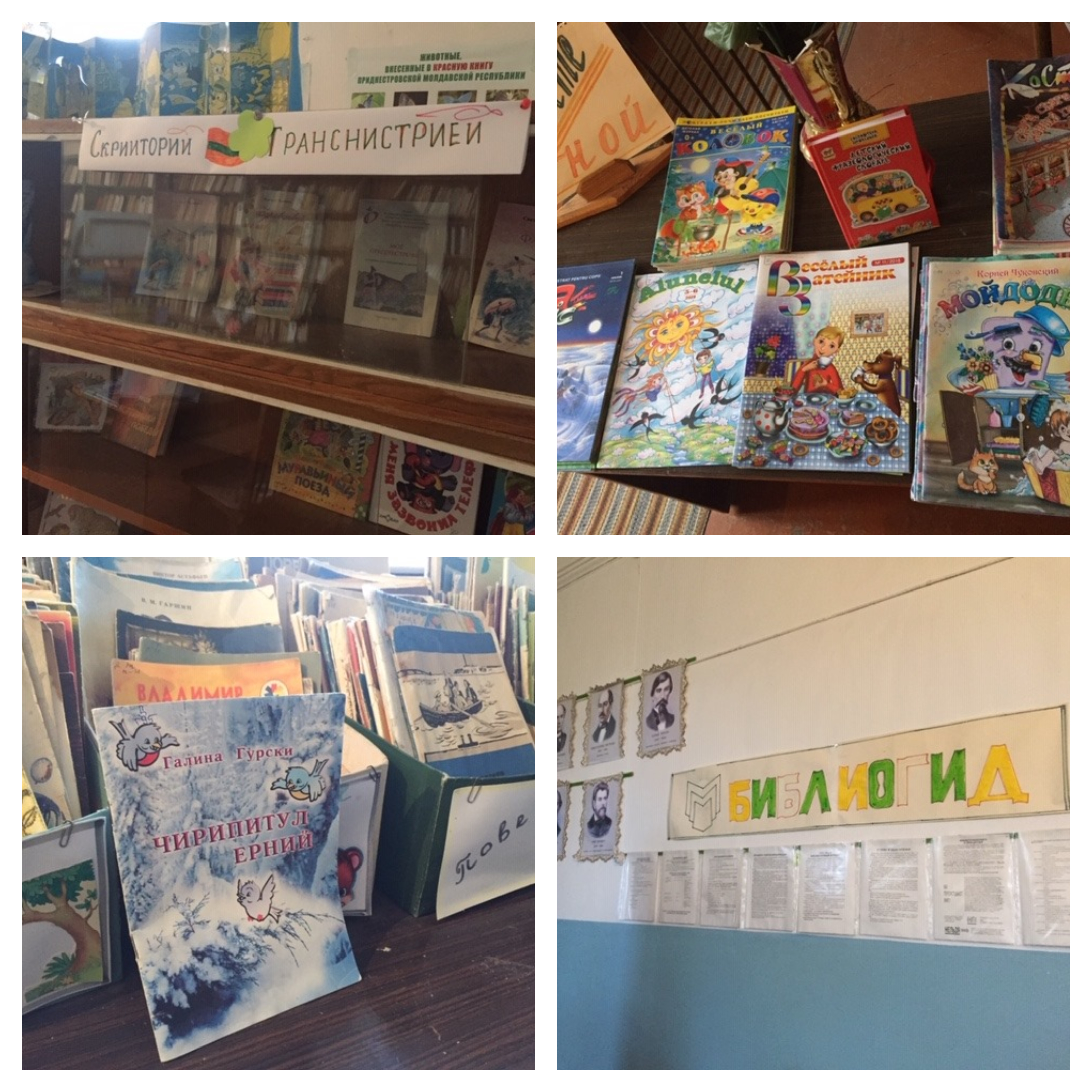
“The children schooled on the left bank of the Nistru are studying and doing well in universities from Moldova, Romania and the Russian Federation. On the right side of the Nistru, they must also pass the baccalaureate exams, because only 11 grades are taught in Transnistria. They are admitted in the first year of college in the Russian Federation,” says a teacher.
The textbooks are published in Tiraspol or Moscow, some of them, such as the textbook for exact sciences, are translated according to Russian textbooks. Others are written by Russian authors, selected from Tiraspol, among those "who write closer to the realities of Transnistria." The textbooks are printed in Tiraspol. At lessons of Moldovan language and literature, children learn about some works of Moldovan writers and poets, which were studied during Soviet times.
At the library, we see textbooks with Cyrillic writing, strongly ideologized. The children learn the History of Russia and the History of their hometown, that is, of the Transnistrian region. As we manage to look through them, we notice that much is written about the "Romanian-fascist invaders,” exactly the same as the messages with which Russian propaganda operates in the region. I saw similar textbooks in Abkhazia.
The teachers we are talking with, ask us not to reveal their names in our investigation, because they may have problems.

In the village, we talk to a few passers-by. People agree to talk about the Tiraspol regime, but the views are divided. Some believe that the Operative Group of Russian Troops, former 14th Army is a guarantor of peace, and others say, it should have been evacuated long ago.

One woman tells us that she was a teacher, but she could not work much, especially when they were forced to write in Cyrillic script.
“I respect the Russian people, because I met different people all my life. But when we were asked to write with Cyrillic script, I resigned. Then I worked for a lyceum in the town and I was kindly asked to resign.”
Transnistrian media and propaganda
The small separatist region, recognized by no one, has an area of almost 4,000 square km and a population of about 300 thousand people.
At the kiosks in the towns you find a lot of publications in Russian and local newspapers: „Dnestrovskaia Pravda” (Adevărul Nistrean), „Celovek i ego prava” (Omul și dreptul său), „Pravda Pridnestrovia” (Adevărul Transnistriei), ”Pridnestrovie” (Transnistria), „Vestnik” (Vestitorul), ”Drujba” (Prietenia) and „Adevărul Nistrean”.
The latter is printed in Cyrillic script. The newspapers which we bought in November wrote about the meeting of the president of the self-proclaimed region with the President of Moldova Igor Dodon. In 2016, for the first time since the war on the left bank of the Nistru, the population of the region was allowed by the Tiraspol authorities to vote for the candidate in the presidential elections in Moldova, and in the 2019 parliamentary elections, 3 constituencies were opened for the districts on the left side of the Nistru. Three MPs, representing the population from the Transnistrian region, have access to the Chisinau Legislative.

The newspaper „Novoe vremea” (Timpul nou) is printed in Tighina and the newspaper „Slobodzeiskie Vesti” (Știrile Sloboziei) in Tighina, the newspaper Zarea Pridnestrovia (Zorile transnistrene) is printed in Dubăsari. A newspaper in Ukrainian „Gormin” is published in Tiraspol. All newspapers are funded by the local administration and just one opinion prevails in the editorial policy- the official one and many ideologized materials, with anti-European and pro-Russian messages.
There is only one independent newspaper, in Rabnita town– „Dobryi deni” (Bună ziua). The independence of this newspaper is due to the fact that it publishes mainly articles about culture and entertainment and nothing about the administration of the region.
In the transnistrian region, there are 6 TV channels: State TV ”Pervii Pridnestrovskii”, municipal TV channel Tighina, private TSV „Телевидение свободного выбора” (Televiziunea opțiunilor libere) of Sheriff holding, a company that controls the region and the force behind the political party Obnovlenie. LikTV broadcasts in Rabnita and the first TV on Internet - Dnestr TV (Nistru TV) is broadcasting in Tighina.

"24 radio frequencies used by Moscow for propaganda in Europe"
The editorial content of most newspapers and TV shows in the region are not very different - the same political, economic and social messages, praising Moscow and the secessionist administration.
"In Transnsitria, there is a strong process of russification, bigger than in the Soviet Union,'' says Oazu Nantoi, MP in the Parliament of the Republic of Moldova.
We tried to find out which institution is releasing TV broadcast frequencies in the transnistrian region, because we did not find any info about the Transnistrian region on the web page of the Audiovisual Council in Moldova.
Unlike the right bank of the Nistru, districts on the left bank of the Nistru river switched to digital television, based on local terrestrial frequencies. Basically, the analogue TV frequencies in Chisinau were blocked. "If the right side of the Nistru switches to digital TV, then we will have the opportunity to broadcast the TV signal in Transnistria," says Vasile Năstase, MP in the Parliament of Moldova, vice-president of the Parliament’s Media Commission.
"The frequencies used in the Transnistrian region are now digital, they are the property of Moldova, but they are used indefinitely by separatists, with the tacit agreement of the Moldovan authorities. The Moldtelecom network and other properties seized by the unconstitutional regime are also used. Also, Russian frequencies are used for the benefit of the Russian Federation,” said Vasile Nastase.
Also, 2 frequencies by the transmitter from Maiac, Grigoriopol, which broadcast 2 TV channels of the public radio station - Radio Moldova and Luceafărul, are now owned by the separatists from Tiraspol.
"There are still 24 frequencies of the Russian Federation, from the Soviet period, that transmitted signals through the powerful transmitter to Latin America, Australia, Europe. This process continues and the biggest problem is that the Russian Federation uses the constitutional territory of the Republic of Moldova to broadcast to different world countries, and what is emitted from here is pure propaganda, which, in my opinion, impinges on the information security of the Republic of Moldova and of other states", says the MP.
Vasile Nastase said that he recently made 2 phone calls to the SIS and to the National Service for Radio Frequency Management to settle the situation.
Investigations in the same category:
The stories from www.anticoruptie.md may be used in the limit of up to 1,000 characters. Web pages must indicate the source and link directly to the article. Print media, Radio and TV stations must indicate the source. Publishing full version of stories is allowed based on a prior agreement with the Center for Investigative Journalism. Articles published on www.anticoruptie.md are protected by the Law on copyright and related rights of Republic of Moldova.
Comments
